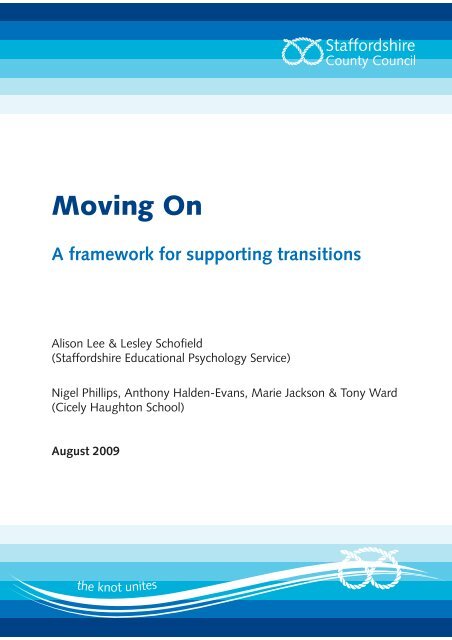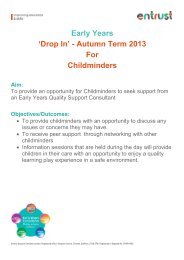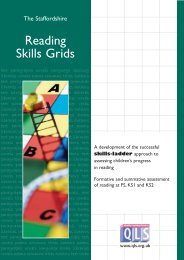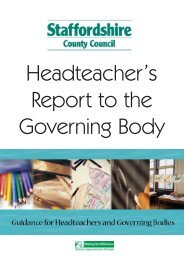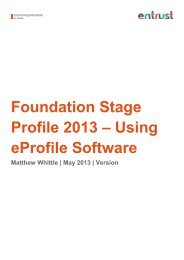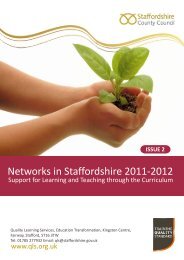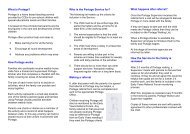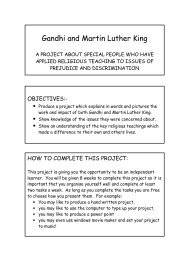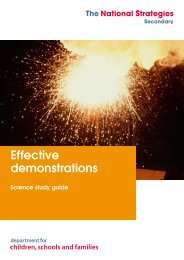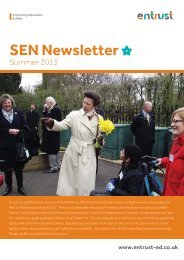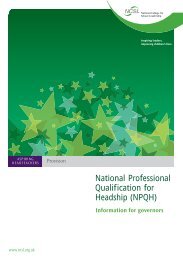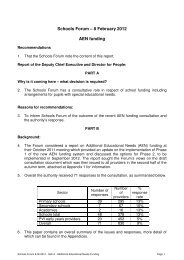Moving On: A Framework for Transitions - Staffordshire Learning Net ...
Moving On: A Framework for Transitions - Staffordshire Learning Net ...
Moving On: A Framework for Transitions - Staffordshire Learning Net ...
Create successful ePaper yourself
Turn your PDF publications into a flip-book with our unique Google optimized e-Paper software.
<strong>Moving</strong> <strong>On</strong><br />
A framework <strong>for</strong> supporting transitions<br />
Alison Lee & Lesley Schofield<br />
(Staf<strong>for</strong>dshire Educational Psychology Service)<br />
Nigel Phillips, Anthony Halden-Evans, Marie Jackson & Tony Ward<br />
(Cicely Haughton School)<br />
August 2009
Background to this Document<br />
Cicely Haughton School is a school which caters <strong>for</strong> KS1 and KS2 children whose primary special<br />
educational needs arise from behavioural, emotional and social difficulties. The school supports<br />
pupil development in these areas and strives to prepare as many pupils as possible <strong>for</strong><br />
a return to their local mainstream school. Such moves are not appropriate <strong>for</strong> all pupils and some<br />
do transfer to other special schools and units. However, all pupils will, at some point, need to<br />
move on.<br />
Over several years, work around transition has become well established at Cicely Haughton<br />
School, where staff have successfully facilitated many pupil transitions into local mainstream<br />
settings. Most of these happened at the end of KS2, but there were also pupils who were<br />
transitioning at the end of assessment placements or at other stages be<strong>for</strong>e Y6.<br />
In 2007/2008, staff at Cicely Haughton School decided that it would be helpful to review their<br />
practice and procedure in this area. This was done in collaboration with members of the<br />
Educational Psychology Service. There were three aims:<br />
To build on the foundation of established CHS practice and procedure<br />
To maintain links to other related work at CHS (such as the use of nferNelson Emotional<br />
Literacy materials)<br />
To draw on the experience of successful transitions already undertaken<br />
This document is a culmination of the work done to identify the key elements of the good practice<br />
that was already taking place, and to provide a framework <strong>for</strong> pursuing a consistent model of<br />
delivery. It is also hoped that the framework will be a useful resource <strong>for</strong> other schools<br />
undertaking similar work.<br />
With this in mind, the document has been adjusted by removing specific references to Cicely<br />
Haughton School. However, the following aspects and terms warrant explanation:<br />
The Transition Profile (Appendix 2) focuses on the social and emotional skills that are<br />
particularly relevant when planning transition. It is designed to complement other data<br />
routinely gathered by schools to in<strong>for</strong>m IEP planning. The Transition Profile can also be<br />
used to help plan future work with pupils.<br />
At Cicely Haughton School Marie Jackson was appointed as a Family Links Coordinator to<br />
undertake home-school liaison. Other schools may not have a designated person in this<br />
role and would need to identify who would be best placed to do this work.<br />
There is also a Transition Coordinator (Anthony Halden-Evans), whose role is to oversee<br />
the actual process once pupils have been identified <strong>for</strong> transition. Other schools will need<br />
to decide if this will be a specific role in their school.<br />
Given the potential numbers of pupils transitioning at one time, Cicely Haughton School<br />
decided to create the role of Transition Link Teacher. This person acts as a point of contact<br />
<strong>for</strong> class teams when they consider that a pupil may be ready to embark on the transition<br />
process. The Transition Link Teacher (Tony Ward) ensures that data is gathered and that<br />
there is communication within school – thereby relieving the Transition Coordinator of<br />
these responsibilities. Other schools might choose not to have this role.<br />
This work would not have been possible without the time and ef<strong>for</strong>t given by the Head Teacher,<br />
Nigel Phillips, and staff at Cicely Haughton School. We would like to thank them <strong>for</strong> their<br />
sustained commitment to the project.<br />
Alison Lee and Lesley Schofield<br />
Alison Lee and Lesley Schofield (Staf<strong>for</strong>dshire EPS) and staff at Cicely Haughton School<br />
August 2009<br />
2
MOVING ON – A framework <strong>for</strong> supporting transitions<br />
This document has been devised to support pupils with recognised special<br />
educational needs who are making a transition between schools. The initial focus<br />
was on pupils who were moving from a special school setting into a mainstream<br />
school. However, those using the materials in a pilot study were of the opinion that<br />
this is a resource which could be applicable <strong>for</strong> use with any pupil moving on from<br />
a special school or setting.<br />
The document comprises a summary of relevant research, an overview of a<br />
suggested process, and a series of pro<strong>for</strong>mas designed to prompt thinking,<br />
discussion and actions. (These could be combined into a pupil-focused booklet.)<br />
Finally, there is in<strong>for</strong>mation on some selected resources which may be of interest.<br />
CONTENTS<br />
Elements of Effective Transition – Research Background<br />
Transition Process – Step by Step<br />
Transition Process – A Flow Chart<br />
Pupils Being Considered <strong>for</strong> Transition - Record of Outcomes<br />
Preliminary Transition Meeting – Initial Outcomes<br />
Preliminary Transition Meeting – Follow-up Outcomes<br />
Transition Meeting - Data Checklist<br />
Transition Meeting Agenda<br />
Transition Meeting – Record of Outcomes<br />
Transition Review Meeting Agenda<br />
Transition Review Meeting – Record of Outcomes<br />
Useful Resources<br />
Appendix 1 - Expanded Contents Page<br />
Appendix 2 - Transition Profile <strong>for</strong> Pupils with Behavioural, Emotional and Social<br />
Difficulties<br />
Appendix 3 - Post-transition questionnaires (as used in the original project work)<br />
Appendix 4 - Front page <strong>for</strong> post-transition profile<br />
Alison Lee and Lesley Schofield (Staf<strong>for</strong>dshire EPS) and staff at Cicely Haughton School<br />
August 2009<br />
FORM<br />
1<br />
2<br />
3<br />
4<br />
5<br />
6<br />
TP<br />
PAGE<br />
5-6<br />
7-9<br />
10-11<br />
13<br />
15<br />
17<br />
19<br />
21-22<br />
23<br />
25 -26<br />
27<br />
29<br />
31-32<br />
33-39<br />
41-44<br />
45<br />
3
Alison Lee and Lesley Schofield (Staf<strong>for</strong>dshire EPS) and staff at Cicely Haughton School<br />
August 2009<br />
4
Research background<br />
Elements of Effective Transition<br />
1. DfES Research Brief 131 (Galton et al., 1999) identifies five main areas of activity which<br />
schools need to engage in to facilitate transition between settings. These areas of activity are<br />
described as ‘bridges’:<br />
The bureaucratic bridge (involving <strong>for</strong>mal liaison between schools,<br />
often at the senior management level)<br />
The social bridge (helping students and their caregivers to develop<br />
social links with the new school be<strong>for</strong>e and after transfer; student induction into the new<br />
school)<br />
The curriculum bridge (sharing plans <strong>for</strong> the content of what is taught be<strong>for</strong>e and after<br />
transfer)<br />
The pedagogy bridge (developing a shared understanding of the kind of teaching and learning<br />
approaches students will benefit from)<br />
The management of learning bridge (helping students to manage transition through<br />
understanding their own strengths and needs and being able to articulate these)<br />
2. ‘This time I’ll stay’, a document published in 2000 by the charity INCLUDE, identifies the<br />
following features associated with the effective transition of students with emotional and<br />
behavioural difficulties into mainstream schools:<br />
Engaging the young person<br />
Identifying and meeting pupil needs through careful assessment, planning and review<br />
Effective behaviour management systems in schools<br />
Addressing basic skills deficits<br />
Paying attention to the specific needs of ‘at risk’ groups (e.g. looked-after children; young<br />
offenders)<br />
3. In ‘Challenging behaviours in mainstream schools’, Jane McSherry (2001) describes a<br />
mainstream reintegration programme. The essential elements of this are:<br />
Assessment (of pupils’ readiness <strong>for</strong> reintegration)<br />
Preparation (through interventions designed to help pupils develop the skills they will need in<br />
order to re-integrate successfully)<br />
Support (<strong>for</strong> pupils and receiving schools, post reintegration)<br />
4. ‘Aspects of Effective Transition’ (QLS, 2004) draws on DfES Research Brief 131 (see 1,<br />
above) and other national and local research. Here, the elements of the five ‘bridges’ are brought<br />
under three category headings:<br />
The transfer and use of data<br />
The continuity and quality of teaching and learning<br />
The physical, social, emotional and spiritual well being of pupils<br />
5. ‘Transition at Key Stage 2-3; supporting positive behaviour and regular attendance’<br />
(PNS Behaviour and Attendance Strategy staff development materials, 2005), also drawing on<br />
DfES Research Brief 131 (see 1, above) and other sources, emphasises the importance <strong>for</strong><br />
effective transition of:<br />
Alison Lee and Lesley Schofield (Staf<strong>for</strong>dshire EPS) and staff at Cicely Haughton School<br />
August 2009<br />
5
Taking active steps to develop children’s social, emotional and behavioural skills<br />
Positive relationships between sending and receiving schools<br />
Carefully planned joint arrangements between sending and receiving schools<br />
Specifically, these materials recommend:<br />
Basing practice on an understanding of the process of change, and human responses to it<br />
Effective administration procedures, derived from collaborative planning about the documents<br />
to be passed on, their contents and delivery dates<br />
Curriculum support in developing the social, emotional and behavioural skills, knowledge and<br />
understanding that will enable children to manage the challenges and opportunities of saying<br />
goodbye (closure) and joining a new community (moving on) with a positive attitude and<br />
emotional resilience<br />
An ethos in both pre- and post-transfer schools that enables children effectively to manage the<br />
social and emotional aspects of learning<br />
Jointly planned practical and concrete activities that reduce children’s anxiety and support<br />
them in meeting the new organisational and learning demands of transfer<br />
Summary comments<br />
Although there is considerable overlap in these findings, the focus of particular pieces of research<br />
varies. For example, Jane McSherry focuses on developing pupil skills, whereas DfES Research<br />
Brief 131 (see 1, above) takes a much broader view of what is necessary to ensure effective<br />
transition, including matters such as administrative processes, curriculum, and whole-school<br />
systems and ethos.<br />
In devising a transition process <strong>for</strong> CHS, we have taken this kind of broad view and have tried to<br />
ensure that the process we offer embraces the range of perspectives in the pieces of research<br />
described above, as well as it being flexible enough to take account of their various findings. In<br />
addition, we have considered work on supporting pupils with attachment difficulties and specific<br />
guidance <strong>for</strong> pupils with an Autism Spectrum Disorder. Relevant in<strong>for</strong>mation from these sources<br />
has also been incorporated into this transition process.<br />
Bibliography<br />
Broderick, K and Mason-Williams, T. (2005) Transition Toolkit , BILD Publications, Kidderminster.<br />
Bomber, L.M. (2007) Inside I’m Hurting, Worth Publishing Ltd., London.<br />
Doyle, R. (2001) Using a readiness <strong>for</strong> reintegrating pupils with social, emotional and behavioural difficulties from a<br />
Nurture Group into their mainstream school – a pilot study, British Journal of Special Education Vol 28, 3, p126-132<br />
Galton, M., Gray, J. & Ruddock, J. (1999) The impact of school transitions and transfers on pupil progress and<br />
attainment, DfES Research Brief 131, DfES, London.<br />
INCLUDE (2000) This time I’ll stay: Reintegrating young people permanently excluded from school, INCLUDE, Ely,<br />
Cambridgeshire.<br />
McSherry, J. (2001) Challenging behaviours in mainstream schools: Practical strategies <strong>for</strong> effective intervention and<br />
reintegration, David Fulton Publishers, London.<br />
PNS (2005) Transition at Key Stage 2-3: supporting positive behaviour and regular attendance (one of 20+ modules in<br />
PNS Behaviour and attendance: developing skills - staff development materials)<br />
Staf<strong>for</strong>dshire QLS (2004) Aspects of effective transition: Supporting the Staf<strong>for</strong>dshire Primary & Secondary Strategies<br />
Watson, A, Hughes, M and Sungum-Paliwal, R, (2006) Enabling the transition of pupils with ASD into secondary<br />
school, Good Autism Practice Vol 7, No.2 p23-36<br />
Alison Lee and Lesley Schofield (Staf<strong>for</strong>dshire EPS) and staff at Cicely Haughton School<br />
August 2009<br />
6
1. Stage 1 – Initiating the process<br />
TRANSITION PROCESS – STEP BY STEP<br />
1.1 Class team (CT + TA), and where appropriate, residential staff, feel that pupil’s progress<br />
indicates pupil may be ready <strong>for</strong> transition (this should be evidence based e.g. NFER<br />
profiles).<br />
Or<br />
Pupil is in year 5 and subject to a transition review<br />
Or<br />
Pupil is nearing the end of an assessment placement<br />
1.2 In<strong>for</strong>mation is shared and discussed with parents/carers and the transition process is<br />
explained.<br />
1.3 If parents/carers are not in agreement with the intention to initiate transition then the<br />
process should be deferred whilst further discussions take place. In schools where there is<br />
a Family Links Coordinator (FLC) or family liaison role, then this person should become<br />
involved.<br />
1.4 CT arranges to complete the Transition Profile (Form TP, Appendix 2). Where there are<br />
a number of pupils who may be transitioning, a school may identify a Transition Link<br />
Teacher (TLT) whose role is to oversee and co-ordinate the various arrangements. The<br />
TLT could be responsible <strong>for</strong> issuing and collecting in the Transition Profiles.<br />
1.5 All relevant staff contribute to completion of the Transition Profile. Parents should also give<br />
their perspective (this may be separately). Copies of the profile should be returned to the<br />
TLT.<br />
1.6 For pupils who must transition, go to 1.8.<br />
1.7 Where a decision is to be made as to whether a pupil is ready to transition, the Transition<br />
Profile score will be one indicator that can be used. A score of around 218 is used by<br />
Rebecca Doyle as a guide to ‘readiness’. However this should be used flexibly, and staff<br />
should consider the overall pupil profile and use their professional judgement to come to a<br />
decision about the best way to proceed. Other measures will also be relevant. Schools<br />
should decide who has responsibility <strong>for</strong> the final decision as to whether to go ahead with<br />
transition. This may be the Senior Leadership Team (SLT), the TLT or the SENCo. In the<br />
flow chart, this role is taken by the TLT.<br />
1.8 When completed Transition Profiles are returned, the TLT records the in<strong>for</strong>mation on the<br />
Record of Outcomes (Form 1), along with the decision as to whether to proceed with<br />
transition. This is a useful means of keeping track of decisions in schools where transitions<br />
occur frequently.<br />
1.9 Schools should agree how best to communicate decisions to the rest of the school staff.<br />
This may be via a regular slot at a staff meeting.<br />
1.10 <strong>On</strong>ce the decision to proceed has been taken, the Transition Process can be started.<br />
The school must decide who takes responsibility <strong>for</strong> the subsequent steps. This may be a<br />
Transition Coordinator (TC) as is the case at Cicely Haughton School, or it may be the<br />
relevant class teacher, or the SENCo. In the flow chart, the role is designated to a TC.<br />
1.11 The TLT is responsible <strong>for</strong> monitoring and reviewing this part of the process.<br />
Alison Lee and Lesley Schofield (Staf<strong>for</strong>dshire EPS) and staff at Cicely Haughton School<br />
August 2009<br />
7
2. Stage 2 – Identifying a receiving school<br />
2.1 The TC calls a Preliminary Transition Meeting. The purpose is to agree the direction of<br />
transition (to a mainstream setting or to an alternative special school) and the options to be<br />
explored. Parents/carers should be invited along with any key support staff who may be<br />
able to give an in<strong>for</strong>med input to the discussion. Use Preliminary Transition Meeting –<br />
Initial Outcomes (Form 2) to record agreed options and the reasons <strong>for</strong> their inclusion.<br />
Identify probable sources of support <strong>for</strong> the transition, and record these in the ‘Suggested<br />
Team around the Child’ table.<br />
2.2 Consideration should be given on how best to involve the pupil in this part of the process.<br />
2.3 The TC should copy and circulate Form 2. This is intended to be <strong>for</strong> in<strong>for</strong>mation only, but<br />
will hopefully act as a trigger <strong>for</strong> sharing any other relevant in<strong>for</strong>mation. (For example, an<br />
assessment officer may be aware of school factors that might be barriers to successful<br />
inclusion, and such in<strong>for</strong>mation could be helpful.)<br />
2.4 The TC awaits and considers initial feedback.<br />
2.5 The TC may request support <strong>for</strong> approaching those schools where other people, perhaps<br />
in the support agencies, might have established working relationships.<br />
2.6 The TC approaches possible schools and establishes their willingness to support a<br />
transition into their setting.<br />
2.7 <strong>On</strong>ce an identified school has agreed to a placement in principle, the TC completes<br />
Preliminary Transition Meeting – Follow-up Outcomes (Form 3) and distributes this.<br />
2.8 At this stage there is likely to be an initial provision of pupil-focused in<strong>for</strong>mation in order <strong>for</strong><br />
the identified school to be able to make a firm commitment to receiving the pupil. This<br />
might include some elements listed on the Data Checklist (Form 4). The TC should<br />
identify the in<strong>for</strong>mation that will be helpful to the receiving school, bearing in mind that they<br />
need sufficient in<strong>for</strong>mation to make a decision but not so much as to be overloaded.<br />
2.9 If the receiving school <strong>for</strong>mally agrees to placement, the TC proceeds with setting up a<br />
Transition Meeting involving the ‘Team around the Child’.<br />
2.10 Should the identified school decide that it is unable to proceed at this point, return to 2.1<br />
or 2.6, as appropriate, and repeat the process.<br />
3. Stage 3 – Detailed transition planning<br />
3.1 The TC sets up a Transition Meeting. The Transition Meeting Agenda gives guidance on<br />
the context <strong>for</strong> the meeting and how to set it up. It also provides detailed guidance on the<br />
agenda itself and how to use the Data Checklist (Form 4) to decide on in<strong>for</strong>mation to be<br />
shared and with whom.<br />
3.2 Consideration should be given on how best to involve the pupil in this part of the process.<br />
3.3 Proceedings and outcomes of the Transition Meeting should be recorded on Transition<br />
Meeting – Record of Outcomes (Form 5).<br />
3.4 Agreed arrangements should be initiated.<br />
Alison Lee and Lesley Schofield (Staf<strong>for</strong>dshire EPS) and staff at Cicely Haughton School<br />
August 2009<br />
8
3.5 The implementation of arrangements should be closely monitored in the period leading up<br />
to the move of school and immediately afterwards. These arrangements should be agreed<br />
at the Transition Meeting and should not run <strong>for</strong> longer than 6 weeks without a review. (The<br />
nature of a review can vary according to need.)<br />
3.6 Six weeks after the pupil has made the transition, a Transition Review Meeting should be<br />
arranged. The TC would usually take responsibility <strong>for</strong> this. The Transition Review<br />
Meeting Agenda gives guidance on preparing <strong>for</strong> and setting up this meeting, as well as<br />
providing a suggested agenda <strong>for</strong> the meeting itself.<br />
3.7 Good practice suggests that transition arrangements that involve the ‘feeder’ school can be<br />
a supportive bridge <strong>for</strong> some pupils. However, such arrangements should include planning<br />
<strong>for</strong> withdrawal of such support, with the receiving school taking full control of the process at<br />
this stage.<br />
3.8 Proceedings of the Transition Review Meeting should be recorded on Transition Review<br />
Meeting – Record of Outcomes (Form 6).<br />
3.9 Transition periods will vary in length according to the needs of pupils.<br />
4. Stage 4 – Reflection and review<br />
4.1 The Transition Review Meeting will provide in<strong>for</strong>mation on the initial success or otherwise<br />
of a transition. It will also provide a point at which support arrangements can be reviewed,<br />
and, if necessary, changed. Review feedback will thus in<strong>for</strong>m arrangements <strong>for</strong> an<br />
individual pupil, but may also be used to monitor and review the process itself.<br />
4.2 The Transition Profile can be used as a pupil-focused planning and monitoring tool at<br />
various points in the process. For example, it can be used be<strong>for</strong>e a school move to identify<br />
areas of focus <strong>for</strong> the pupil with regard to developing new skills. It can also suggest where<br />
support should be directed. Immediately be<strong>for</strong>e transition, it can be used to identify<br />
possible IEP target areas. <strong>On</strong>ce the pupil is in the new school, it can be used intermittently<br />
to review progress.<br />
4.3 In Appendix 4 there is a front cover which can be added to the Transition Profile when<br />
using it <strong>for</strong> reviews.<br />
Alison Lee and Lesley Schofield (Staf<strong>for</strong>dshire EPS) and staff at Cicely Haughton School<br />
August 2009<br />
9
Class team identifies<br />
pupil as candidate<br />
<strong>for</strong> reintegration<br />
Parents do not<br />
agree - defer<br />
process - involve<br />
Family Links<br />
Coordinator (FLC)<br />
TRANSITION PROCESS – A FLOW CHART<br />
Pupil in<br />
Year 5<br />
Share/discuss in<strong>for</strong>mation with<br />
parents/carers<br />
Parents agree - CT/FLC liaises with<br />
Transition Link Teacher (TLT) - TLT<br />
issues Transition Profile (Form TP,<br />
Appendix 2) - class team completes<br />
Transition Profile<br />
Completed Transition Profile returned<br />
to TLT - complete Record of<br />
Outcomes (Form 1) - decision to<br />
start transition process based on age<br />
or Transition Profile score<br />
TC starts Transition Process<br />
Preliminary Transition Meeting<br />
Preliminary Transition Meeting Initial<br />
Outcomes (Form 2) distributed to<br />
potential Team around Child<br />
End of<br />
assessment<br />
placement<br />
Alison Lee and Lesley Schofield (Staf<strong>for</strong>dshire EPS) and staff at Cicely Haughton School<br />
August 2009<br />
Gather relevant data<br />
(eg NfER Emotional<br />
Literacy Assessment)<br />
If not a Y5 or<br />
assessment<br />
placement, check<br />
whether parents/carers<br />
are in agreement<br />
If necessary, involve<br />
FLC and defer process<br />
until concerns are<br />
addressed<br />
Share/discuss<br />
in<strong>for</strong>mation with<br />
parents /carers -<br />
explore perceptions<br />
and expectations<br />
(could use NFER<br />
parent questionnaires)<br />
Score and profile will<br />
indicate direction of /<br />
readiness <strong>for</strong> transition<br />
TLT alerts Transition<br />
Coordinator (TC) &<br />
completes Record of<br />
Outcomes (Form 1) –<br />
shares in<strong>for</strong>mation at<br />
weekly staff meeting<br />
TC arranges<br />
preliminary meeting to<br />
explore school options<br />
& suggest Team<br />
around Child – include<br />
parents/carers, FLC,<br />
CT & other agencies<br />
as appropriate –<br />
explore how to<br />
involve pupil<br />
TC chairs – agenda<br />
as per Preliminary<br />
Transition Meeting –<br />
Initial Outcomes<br />
(Form 2)<br />
Consider support <strong>for</strong><br />
TC in approaching<br />
particular schools<br />
(eg generic special<br />
schools)<br />
Complete &<br />
distribute Form 2<br />
Consider any<br />
feedback<br />
10
Approach to school<br />
unsuccessful -<br />
record on<br />
Preliminary<br />
Transition Meeting<br />
Follow-up Outcomes<br />
(Form 3)<br />
Revise individual<br />
programme to reflect<br />
future support needs<br />
Possible school(s) approached<br />
School agrees to<br />
placement in principle<br />
- complete and<br />
distribute Preliminary<br />
Transition Meeting<br />
Follow-up Outcomes<br />
(Form 3)<br />
No options left Preliminary exchange<br />
of in<strong>for</strong>mation and<br />
planning<br />
School <strong>for</strong>mally<br />
agrees to placement<br />
TEAM AROUND CHILD<br />
TRANSITION MEETING<br />
Arrangements initiated<br />
6 weeks<br />
6-week<br />
Transition<br />
Review Meeting<br />
6 weeks<br />
12-week/end-of-term review<br />
meeting - decision point<br />
Feeder school withdraws support<br />
6 weeks<br />
Alison Lee and Lesley Schofield (Staf<strong>for</strong>dshire EPS) and staff at Cicely Haughton School<br />
August 2009<br />
TC with support from<br />
Team around Child<br />
where appropriate<br />
(e.g. <strong>for</strong> generic<br />
special schools) -<br />
parent/carer<br />
involvement<br />
throughout<br />
TC arranges Transition<br />
Meeting, to include<br />
parents/carers and<br />
Team around Child<br />
TC ensures necessary<br />
data brought to<br />
meeting - see<br />
Transition Meeting<br />
Data Checklist<br />
(Form 4)<br />
See Transition<br />
Meeting Agenda<br />
Complete Transition<br />
Meeting – Record of<br />
Outcomes (Form 5)<br />
Usually there is a<br />
rolling 6-weekly review<br />
cycle with at least 2<br />
reviews once pupil is<br />
attending full time.<br />
Full team around the<br />
child or key people as<br />
appropriate - see<br />
Transition Review<br />
Meeting Agenda<br />
Complete Transition<br />
Review Meeting -<br />
Record of Outcomes<br />
(Form 6)<br />
Usual point at which<br />
receiving school takes<br />
control of process<br />
11
Alison Lee and Lesley Schofield (Staf<strong>for</strong>dshire EPS) and staff at Cicely Haughton School<br />
August 2009<br />
12
PUPILS BEING CONSIDERED FOR TRANSITION - RECORD OF OUTCOMES<br />
Pupil Data Action<br />
Name DOB Class<br />
Teacher<br />
Transition<br />
Profile Score<br />
Referred to<br />
Transition<br />
Coordinator<br />
(date)<br />
Alison Lee and Lesley Schofield (Staf<strong>for</strong>dshire EPS) and staff at Cicely Haughton School<br />
August 2009<br />
Other<br />
Form 1<br />
13
Alison Lee and Lesley Schofield (Staf<strong>for</strong>dshire EPS) and staff at Cicely Haughton School<br />
August 2009<br />
14
PRELIMINARY TRANSITION MEETING – INITIAL OUTCOMES Form 2<br />
This summary is to in<strong>for</strong>m you of suggested transition options <strong>for</strong> the following pupil. No<br />
action is required on your part. However, if you have any relevant in<strong>for</strong>mation, please<br />
contact the Transition Coordinator ____________________________ by _______________<br />
Please note that schools listed have not yet been approached. You will be notified when a<br />
school has agreed in principle to a placement.<br />
Date of Meeting:<br />
School:<br />
Pupil name: Date of Birth: CAF: YES/NO<br />
(If no, consider if needed.)<br />
Participants:<br />
Direction of Transition: Mainstream Special<br />
SCHOOL OPTIONS TO EXPLORE<br />
School (plus feeder if appropriate) Comments (e.g. basis <strong>for</strong> choice)<br />
1.<br />
2.<br />
3.<br />
Next action(s) required:<br />
NATURE OF PROPOSED FAMILY LINKS COORDINATOR (FLC) INVOLVEMENT:<br />
SUGGESTED ‘TEAM AROUND THE CHILD’:<br />
Name Role Contact details<br />
Copies to: School Parents Assessment Team EP Others in TaC <br />
Alison Lee and Lesley Schofield (Staf<strong>for</strong>dshire EPS) and staff at Cicely Haughton School<br />
August 2009<br />
15
Alison Lee and Lesley Schofield (Staf<strong>for</strong>dshire EPS) and staff at Cicely Haughton School<br />
August 2009<br />
16
PRELIMINARY TRANSITION MEETING – FOLLOW-UP OUTCOMES Form 3<br />
This notification is to keep you in<strong>for</strong>med of progress in exploring transition options <strong>for</strong> the<br />
following pupil. No action is required on your part. However, if you would like further<br />
in<strong>for</strong>mation, or have any in<strong>for</strong>mation to offer, please contact the Transition Coordinator<br />
_______________________________ by _____________________________<br />
Date:<br />
School:<br />
Pupil name: Date of Birth:<br />
SCHOOL OPTION(S) EXPLORED:<br />
1.<br />
2.<br />
3.<br />
School (plus feeder if appropriate)<br />
NEXT ACTION REQUIRED:<br />
Either:<br />
Proceed with preliminary exchange of<br />
in<strong>for</strong>mation and planning<br />
Agreement to placement in principle? YES/NO<br />
Or:<br />
Call another meeting to identify<br />
further school options<br />
CHANGES TO FAMILY LINKS COORDINATOR (FLC) INVOLVEMENT:<br />
(Complete if required.)<br />
CHANGES TO SUGGESTED ‘TEAM AROUND THE CHILD’<br />
(Suggested changes usually arise if an identified school is covered by different support staff.)<br />
Name (and contact details if addition) Role REMOVE ADD<br />
Copies to: School Assessment Team EP Parents Others in TaC <br />
Alison Lee and Lesley Schofield (Staf<strong>for</strong>dshire EPS) and staff at Cicely Haughton School<br />
August 2009<br />
17
Alison Lee and Lesley Schofield (Staf<strong>for</strong>dshire EPS) and staff at Cicely Haughton School<br />
August 2009<br />
18
TRANSITION MEETING – DATA CHECKLIST Form 4<br />
Pupil name: Date of Birth:<br />
Current School: Identified School:<br />
Data<br />
Pupil profile (general) – interests,<br />
strengths and areas <strong>for</strong><br />
development, preferably compiled<br />
in partnership with pupil and<br />
parents/carers<br />
In<strong>for</strong>mation about learning levels<br />
(SATs results; teacher<br />
assessments etc)<br />
In<strong>for</strong>mation about identified SEN -<br />
current and previous IEPs<br />
In<strong>for</strong>mation about identified SEN –<br />
reports e.g. SENSS/EP/ SALT/<br />
CAMHS<br />
Examples of pupils’ work in core<br />
subjects and in<strong>for</strong>mation to<br />
support continuity and progression<br />
in the curriculum<br />
In<strong>for</strong>mation about approach to<br />
learning / learning style / response<br />
to teaching style etc<br />
Transition Profile scores / NfER<br />
Emotional Literacy scores / other<br />
BESD in<strong>for</strong>mation<br />
Any safeguarding issues<br />
Further in<strong>for</strong>mation/comments:<br />
From<br />
whom?<br />
Provided?<br />
YES/NO<br />
Comments<br />
Copies to: School Assessment Team EP Parents Others in TaC <br />
Alison Lee and Lesley Schofield (Staf<strong>for</strong>dshire EPS) and staff at Cicely Haughton School<br />
August 2009<br />
19
Alison Lee and Lesley Schofield (Staf<strong>for</strong>dshire EPS) and staff at Cicely Haughton School<br />
August 2009<br />
20
CONTEXT<br />
TRANSITION MEETING AGENDA<br />
The Transition Meeting is the central opportunity <strong>for</strong> key personnel to share the in<strong>for</strong>mation that will<br />
help a pupil to make a successful move to a new educational setting. There are significant benefits<br />
from bringing people together, but it may be viewed as a time-costly proposal. It is there<strong>for</strong>e vital<br />
that the Transition Meeting is well organised, efficiently run, and productive <strong>for</strong> all concerned. Prior<br />
planning and a clear agenda will pay dividends.<br />
PREPARATION<br />
Prior to the meeting:<br />
Invite relevant people. It is important to involve all key players who will be supporting the<br />
pupil, whilst recognising that too large a meeting will be impractical and probably less<br />
productive. Include:<br />
o Parents/carers<br />
o Pupil. Consider how to prepare the pupil and obtain their views. It is likely to be too<br />
daunting <strong>for</strong> most pupils to attend a full Transition Meeting, but their input is vital.<br />
Consider ways in which the pupil could be involved, perhaps through partial<br />
attendance, or by giving their views via an adult representative. Also plan how and<br />
when feedback will be given.<br />
o Representatives from the current setting who will be able to share and highlight the<br />
most pertinent in<strong>for</strong>mation - e.g. Transition Coordinator; class teacher; head teacher;<br />
care staff; Family Links Coordinator. Talk to significant staff and decide who should<br />
attend. Parents/carers may have a view on this.<br />
o Representatives from the receiving school who will be able to share and highlight<br />
pertinent in<strong>for</strong>mation, and ensure that this is efficiently shared with other colleagues -<br />
e.g. class teacher/<strong>for</strong>m tutor; pastoral head; SENCo; head teacher..<br />
o Bridging staff who can support the transition and provide some continuity <strong>for</strong> the pupil<br />
and family - e.g. Transition Coordinator; Behaviour Support staff (primary and<br />
secondary); educational psychologist (current and receiving school); social worker.<br />
Compile in<strong>for</strong>mation. The Data Checklist (Form 4) suggests in<strong>for</strong>mation that may be helpful.<br />
o Try to ensure a positive and realistic view. Avoid focusing solely on negative issues.<br />
o Some in<strong>for</strong>mation will be appropriate <strong>for</strong> sharing with everyone at the meeting. Some<br />
will only be relevant to certain attendees.<br />
o Decide which in<strong>for</strong>mation is helpful and succinct and can be read/considered at the<br />
meeting.<br />
o More detailed in<strong>for</strong>mation may be referenced and made available <strong>for</strong> those who need<br />
it.<br />
o Ensure that you have permission (from the author and from parents/carers) to share<br />
reports at the meeting.<br />
o Consider compiling a summary of the key players and their details. This would<br />
certainly include the Team around the Child, but might extend to other involved<br />
agencies or support staff. (See example in the Transition Toolkit.)<br />
Arrangements. Decide venue, timings and agenda, and communicate these.<br />
Alison Lee and Lesley Schofield (Staf<strong>for</strong>dshire EPS) and staff at Cicely Haughton School<br />
August 2009<br />
21
AGENDA<br />
Aims/purpose of the meeting<br />
The Transition Meeting is the central opportunity <strong>for</strong> key personnel to share the in<strong>for</strong>mation that will<br />
help a pupil make a successful move to a new educational setting.<br />
Who’s who<br />
Who is present at the meeting? Who else will be involved in transition planning? Possible use of<br />
personnel/contact list – or make signing-in sheet the contact list.<br />
Current picture<br />
What is going well and any recent successes<br />
Any issues/concerns/areas of focus<br />
Strategies/approaches in place<br />
Transition arrangements/proposals<br />
Preparing pupil<br />
This could include:<br />
o ‘We’re <strong>Moving</strong> <strong>On</strong>’ programme activities (Staf<strong>for</strong>dshire Behaviour Support Team)<br />
o In<strong>for</strong>mation (e.g. map/pictures of new school/staff)<br />
o Links with others who are moving to the same setting (e.g. direct contact/letters)<br />
o Visits (with key adult from current school; use of transitional objects i.e. pupil brings something<br />
tangible away from the setting e.g. piece of work/photos)<br />
o Shared activities (e.g. attend club/talk to current pupil in new school)<br />
o Practice the journey to new school<br />
o Use/practice of scripts to help answer questions about reasons <strong>for</strong> being at/time at current school<br />
(especially when moving to a mainstream setting)<br />
o Preparing <strong>for</strong> change/importance of saying goodbyes (compile memory book; say goodbye to<br />
individuals; plan over time – not all to be done on same day)<br />
Preparing parents/carers<br />
o In<strong>for</strong>mation<br />
o Links with receiving school (letters/points of contact)<br />
o Visits<br />
o Shared activities (invite to events at the new school)<br />
Preparing receiving staff<br />
o Opportunities <strong>for</strong> exchange of in<strong>for</strong>mation re pupil (data brought to Transition Meeting by staff at<br />
current school; identification of other in<strong>for</strong>mation that would be helpful)<br />
o Opportunities <strong>for</strong> exchange of in<strong>for</strong>mation re support arrangements<br />
o Curriculum links<br />
o Meeting Transition Coordinator<br />
o Identify new ‘key adult’ and arrange <strong>for</strong> this person to visit pupil in current school<br />
o Identify potential staff training needs (e.g. ASD; attachment; meeting BESD needs) and ensure<br />
that these are addressed prior to transfer if possible<br />
Arrangements <strong>for</strong> arrival<br />
o Points of contact – regular opportunities to meet new key adult<br />
o Support with personal organisation – following school routines and timetable; finding way around<br />
o Ensure availability of a ‘safe haven’ <strong>for</strong> times of stress<br />
o Consider use of Buddies and/or Circle of Friends<br />
o Consider visits from key adult in <strong>for</strong>mer school (September and December) – <strong>for</strong>mer key adult<br />
‘signs off’ by sending card in January – pupil may send in<strong>for</strong>mation back to <strong>for</strong>mer school via adult<br />
Transition timetable<br />
o Plan timetable collaboratively<br />
o Agree how to share timetable and plans with others who may be able to add support<br />
o Agree how progress with the transition will be communicated to all parties<br />
Alison Lee and Lesley Schofield (Staf<strong>for</strong>dshire EPS) and staff at Cicely Haughton School<br />
August 2009<br />
22
TRANSITION MEETING – RECORD OF OUTCOMES Form 5<br />
Pupil name: Date of Birth:<br />
Current School: Identified School:<br />
Present:<br />
Current Picture:<br />
Summary of Discussions<br />
Preparing pupil:<br />
Preparing parents/carers:<br />
Preparing receiving staff:<br />
Arrangements <strong>for</strong> arrival:<br />
Transition timetable:<br />
Further in<strong>for</strong>mation/comments:<br />
Next Actions Who?<br />
Copies to: School Assessment Team EP Parents Others in TaC <br />
Alison Lee and Lesley Schofield (Staf<strong>for</strong>dshire EPS) and staff at Cicely Haughton School<br />
August 2009<br />
23
Alison Lee and Lesley Schofield (Staf<strong>for</strong>dshire EPS) and staff at Cicely Haughton School<br />
August 2009<br />
24
CONTEXT<br />
TRANSITION REVIEW MEETING AGENDA<br />
The Transition Review Meeting is the opportunity <strong>for</strong> key personnel to reflect on the success of the<br />
pupil’s move to a new educational setting, and to consider what, if any, support arrangements need<br />
to be maintained or adapted. There will be benefits from bringing people together, but it may not<br />
be necessary to involve as many people as were present <strong>for</strong> the Transition Meeting.<br />
PREPARATION<br />
Prior to the meeting:<br />
Invite relevant people. It is important to involve key players, particularly those who have<br />
played a critical role in supporting the transition. Include:<br />
o Parents/carers<br />
o Pupil. Consider how to prepare the pupil and obtain their views. If the meeting is not<br />
too large, a pupil may feel able to participate. However, if it is too daunting <strong>for</strong> the<br />
pupil, it is still vital to obtain their input. Consider ways in which the pupil could be<br />
involved, perhaps through partial attendance, or by giving their views via an adult<br />
representative. Also plan how and when feedback will be given.<br />
o Representatives from the current (receiving) setting who will be able to share and<br />
highlight the most pertinent in<strong>for</strong>mation - e.g. pastoral staff; SENCo; head teacher.<br />
Talk to significant staff and decide who should attend. Parents/carers may have a view<br />
on this.<br />
o Representatives from the previous school (e.g. Transition Coordinator; Family Links)<br />
who will be able to collate pertinent in<strong>for</strong>mation <strong>for</strong> analysis/reflection, and <strong>for</strong> sharing<br />
with interested colleagues.<br />
o Bridging staff who have supported the transition and who may continue to support the<br />
pupil and their family - e.g. Behaviour Support staff; educational psychologist (current<br />
school); social worker.<br />
Compile in<strong>for</strong>mation.<br />
o Try to ensure a positive and realistic view. Avoid focusing solely on negative issues.<br />
o Arrange <strong>for</strong> school staff to complete the Transition Profile and ensure that both pre and<br />
post summaries are available at the meeting.<br />
o Talk to others to establish whether there is additional in<strong>for</strong>mation that is needed to<br />
in<strong>for</strong>m the meeting.<br />
Arrangements. Decide venue, timings and agenda, and communicate these.<br />
Alison Lee and Lesley Schofield (Staf<strong>for</strong>dshire EPS) and staff at Cicely Haughton School<br />
August 2009<br />
25
AGENDA<br />
Aims/purpose of the meeting<br />
The Transition Review Meeting is the opportunity <strong>for</strong> key personnel to reflect on the<br />
success of a pupil’s move to a new educational setting, and to consider what, if any,<br />
support arrangements need to be maintained or adapted.<br />
Who’s who?<br />
Who is present at the meeting? Apologies.<br />
Current picture<br />
What is going well and any recent successes<br />
Any issues/concerns/areas of focus<br />
Strategies/approaches in place<br />
Review of transition arrangements<br />
Preparing pupil<br />
o Were all strategies/elements put in place?<br />
o If not, why not?<br />
o What elements were most helpful/beneficial?<br />
o Lessons learned?<br />
Preparing parents/carers<br />
o Were all strategies/elements put in place?<br />
o If not, why not?<br />
o What elements were most helpful/beneficial?<br />
o Lessons learned?<br />
Preparing receiving staff<br />
o Were all strategies/elements put in place?<br />
o If not, why not?<br />
o What elements were most helpful/beneficial?<br />
o Lessons learned?<br />
Arrangements <strong>for</strong> arrival<br />
o Were all strategies/elements put in place?<br />
o If not, why not?<br />
o What elements were most helpful/beneficial?<br />
o Lessons learned?<br />
Transition timetable<br />
o Was planned timetable implemented?<br />
o Did timetable work well?<br />
Outstanding issues<br />
o What support is currently in place?<br />
o Is this meeting current needs?<br />
o Are there plans to change this support? How?<br />
o Future monitoring arrangements<br />
Alison Lee and Lesley Schofield (Staf<strong>for</strong>dshire EPS) and staff at Cicely Haughton School<br />
August 2009<br />
26
TRANSITION REVIEW MEETING – RECORD OF OUTCOMES Form 6<br />
Pupil Name: Date of Birth:<br />
Current School:<br />
Date of Meeting:<br />
Checks Yes/No Comments<br />
Transition profile completed and<br />
outcomes shared<br />
Current school staff feel pupil<br />
has settled<br />
Support staff feel pupil has<br />
settled<br />
Parents/carers feel pupil is<br />
settled<br />
Pupil feels settled<br />
Future support arrangements<br />
agreed<br />
Monitoring arrangements in<br />
place <strong>for</strong> future<br />
Status of ‘Team around the Child’:<br />
Other in<strong>for</strong>mation:<br />
Copies to: School Assessment Team EP Parents Others in TaC <br />
Alison Lee and Lesley Schofield (Staf<strong>for</strong>dshire EPS) and staff at Cicely Haughton School<br />
August 2009<br />
27
Alison Lee and Lesley Schofield (Staf<strong>for</strong>dshire EPS) and staff at Cicely Haughton School<br />
August 2009<br />
28
USEFUL RESOURCES<br />
1. BILD Transition Toolkit<br />
This publication contains in<strong>for</strong>mation, guidance, checklists and strategies which relate to transition.<br />
Section 2 - Templates available to copy, use and/or adapt:<br />
Pupil profile p29-32<br />
This gives a snapshot of the pupil and key in<strong>for</strong>mation. It includes personal details, tried<br />
and tested behavioural strategies, communication strategies, toileting, sensory issues,<br />
general in<strong>for</strong>mation<br />
Summary of transition and key stakeholders p35<br />
Gives a tick box <strong>for</strong> the type of transition and a grid indicating ‘stakeholders’, their role,<br />
name and contact details. - (Comment – the list is not necessarily helpful. It may be better<br />
to have a blank grid <strong>for</strong> a personalised list.)<br />
Identified training needs and support <strong>for</strong> staff p39<br />
Gives a grid with headings as follows: ‘Training <strong>for</strong>’, ‘Type of training/support’, ‘Training<br />
provider’, ‘Date of delivery and notes’.<br />
Pupil in<strong>for</strong>mation relevant to the transition p43-45<br />
Covers number of areas as follows: personal strengths and difficulties, communication,<br />
social skills, curriculum strengths and difficulties, level of support needed, extra-curricular<br />
activities, reports available from other agencies.<br />
Key strategies and resources <strong>for</strong> this transition p49<br />
Gives possible list of strategies and/or resources and space to indicate who will take<br />
responsibility <strong>for</strong> these.<br />
Transition timetable and action plan summary p53<br />
This takes the <strong>for</strong>m of a grid with columns <strong>for</strong>: date, action, action by, notes and signature.<br />
Section 4 – Strategies and guidelines <strong>for</strong> successful transitions:<br />
Social Stories p99<br />
Comic Strip Conversations p104<br />
Pupil passports p106<br />
Further strategies p118<br />
o Additional visits to schools p118<br />
o Buddy system p119<br />
o Circle of Friends p120<br />
o Personal booklet of new in<strong>for</strong>mation (could be CD or film) p122<br />
o Visual aids p122<br />
Section 5 – Literature review (June 2003) on managing change and transitions <strong>for</strong> children with<br />
ASD up to age 12. This is particularly focused on autism. It references DfES Good Practice<br />
Guidelines. Most relevant bits are on p136-138<br />
2. Staf<strong>for</strong>dshire Behaviour Support Team ‘We’re <strong>Moving</strong> <strong>On</strong>’ Programme<br />
The BST has developed a 6-week programme which team members have delivered to Year 6<br />
classes, on request. It provides structured activities in which pupils can explore perceptions, hopes<br />
and fears that they may have about their <strong>for</strong>thcoming move to a high school. This programme has<br />
been well received by staff and pupils.<br />
3. Emotional Literacy Assessment and Intervention<br />
Published by nferNelson in 2003. Southampton Psychology Service, editor Adrian Faupel.<br />
ISBN 0-7087-0363-1. In the words of the editor:<br />
‘Everything you need to evaluate the emotional literacy of an individual or group of pupils<br />
and then to design an intervention, based on the results of the assessment, to support<br />
pupils in developing their emotional literacy.’<br />
Alison Lee and Lesley Schofield (Staf<strong>for</strong>dshire EPS) and staff at Cicely Haughton School<br />
August 2009<br />
29
Alison Lee and Lesley Schofield (Staf<strong>for</strong>dshire EPS) and staff at Cicely Haughton School<br />
August 2009<br />
30
APPENDIX 1<br />
<strong>Moving</strong> <strong>On</strong> – A <strong>Framework</strong> <strong>for</strong> Supporting <strong>Transitions</strong><br />
Contents – expanded<br />
o Elements of Effective Transition – Research Background<br />
This summarises some of the key documents, local and national, which were used to<br />
in<strong>for</strong>m the development of this process. It is not a comprehensive literature review but it<br />
does give the pertinent context.<br />
o Transition Process – Step by Step<br />
An overview of the whole process. It reflects the original Cicely Haughton approach and<br />
there<strong>for</strong>e references particular job titles within that school. Other schools may allocate<br />
responsibilities differently.<br />
The early part of the process is concerned with identifying potential receiving schools and<br />
exploring their suitability and receptiveness. For pupils in BESD settings, this can be a<br />
major challenge and time allocated to this part of the process has been perceived by staff<br />
as time well spent. For Cicely Haughton School, this part of the process was often<br />
undertaken in relative isolation, and it is suggested that <strong>for</strong> some ‘difficult to place’<br />
youngsters, early input from other support agencies can make a significant difference to the<br />
responses of schools approached.<br />
For some pupils, the first part of the process is compressed as there are few issues or<br />
concerns around the identification of the receiving school.<br />
The main ‘Transition Meeting’ follows good practice procedures as encompassed in<br />
guidance on the ‘Team around the Child’.<br />
o Transition Process – Flow Chart<br />
A flow-chart summary of the whole transition process.<br />
The shaded boxes to the right of the flow chart give explanatory notes.<br />
o Pupils Being Considered <strong>for</strong> Transition – Record of Outcomes<br />
This <strong>for</strong>m is particularly useful in settings where there may be significant numbers of pupils<br />
needing transition support and where there is a consequent need to plan and prioritise that<br />
support.<br />
o Preliminary Transition Meeting – Initial Outcomes<br />
This is <strong>for</strong> exploring the direction of transition with all key parties and then identifying what<br />
options are available <strong>for</strong> consideration. It prompts early discussion of who else might be<br />
able to support the process and who should be aware that it has been initiated.<br />
o Preliminary Transition Meeting – Follow-up Outcomes<br />
This records the outcomes of the enquiries/approaches to schools that were identified in<br />
the preliminary meeting.<br />
o Transition Meeting – Data Checklist<br />
Intended as a prompt/aide-memoire - see explanation in ‘Preparation’ section of Transition<br />
Meeting Agenda.<br />
Alison Lee and Lesley Schofield (Staf<strong>for</strong>dshire EPS) and staff at Cicely Haughton School<br />
August 2009<br />
31
o Transition Meeting Agenda<br />
This comprises guidance <strong>for</strong> preparation and running of the meeting. It covers all aspects<br />
identified in the background research papers. This is the core element of the process.<br />
o Transition Meeting – Record of Outcomes<br />
This <strong>for</strong>m provides a further prompt <strong>for</strong> the meeting as well as being a tool <strong>for</strong> recording key<br />
in<strong>for</strong>mation.<br />
o Transition Review Meeting Agenda<br />
This comprises guidance <strong>for</strong> preparation and running of a review meeting. It revisits the<br />
aspects addressed in the transition meeting and encourages reflective practice.<br />
o Transition Review meeting – Record of Outcomes<br />
This <strong>for</strong>m provides a further prompt <strong>for</strong> the meeting as well as being a tool <strong>for</strong> recording key<br />
in<strong>for</strong>mation.<br />
o Useful Resources<br />
This is just a reference to some key resources. There are many more.<br />
o Appendix 2 - Transition Profile <strong>for</strong> Pupils with Behavioural, Emotional and Social<br />
Difficulties (Form TP)<br />
This is not just a ‘transition’ profile. It is an assessment tool that considers five areas of<br />
development that impact on a pupil’s attitude and approach to learning. It uses positively<br />
phrased statements which can be used to <strong>for</strong>mulate individual targets <strong>for</strong> pupil<br />
programmes. The project explored options <strong>for</strong> staff completing profiles (individually and<br />
then collated; as a whole staff team; key staff pairs).<br />
The rating scales can be used as pre and post intervention measures.<br />
Although the front page references the author’s use of an overall score as an indication of<br />
readiness <strong>for</strong> a mainstream school environment, it is recognised that this is a crude usage<br />
of a tool that provides far greater scope <strong>for</strong> analysis.<br />
The profile is used routinely by both Cicely Haughton School and Loxley Hall School –<br />
af<strong>for</strong>ding the opportunity to monitor across settings.<br />
o Appendix 3 – CHS Transition Follow-Up ( <strong>for</strong>ms)<br />
Copies of the semi-structured interview schedules which were used to gather in<strong>for</strong>mation<br />
on a cohort of pupils who had left Cicely Haughton School. The in<strong>for</strong>mation gathered<br />
in<strong>for</strong>med this document. The framework could be adapted and used by other schools to<br />
monitor the effectiveness of their own transition work.<br />
o Appendix 4 – Alternative front page <strong>for</strong> Transition Profile<br />
This is an alternative front page <strong>for</strong> use when the Transition Profile is used <strong>for</strong> follow-up.<br />
Alison Lee and Lesley Schofield (Staf<strong>for</strong>dshire EPS) and staff at Cicely Haughton School<br />
August 2009<br />
32
APPENDIX 2<br />
Transition profile <strong>for</strong> pupils with behavioural, emotional and<br />
social difficulties<br />
The profile considers five main areas:<br />
Self-control and management of behaviour<br />
Social skills<br />
Self-awareness and confidence<br />
Skills <strong>for</strong> learning<br />
Approach to learning<br />
Allocate a score of between 1 and 4 to each of the statements as follows:<br />
1= rarely fulfils this criterion<br />
2= sometimes fulfils this criterion<br />
3= frequently fulfils this criterion<br />
4= almost always fulfils this criterion<br />
The numerical score at the end of each main area is totalled and plotted on the<br />
grid with a maximum score of 312. The profile will indicate areas of relative<br />
strength as well as areas <strong>for</strong> further development. The profile can there<strong>for</strong>e be<br />
used to in<strong>for</strong>m IEP targets, track progress and in<strong>for</strong>m planning <strong>for</strong> transition.<br />
An overall score of 218 (70%) or above gives an indication that the pupil may<br />
be ready <strong>for</strong> transition into a mainstream classroom.<br />
This profile is based on materials developed by Rebecca Doyle (2001) and Jane<br />
McSherry (1999).<br />
Alison Lee and Lesley Schofield (Staf<strong>for</strong>dshire EPS) and staff at Cicely Haughton School<br />
August 2009<br />
Form TP<br />
33
1.Self control and management of behaviour<br />
Can accept discipline without argument or sulking<br />
Can arrive in classroom and settle down quietly and appropriately<br />
Does not leave the room without permission<br />
Can accept changes to plans or disappointment with an even temper<br />
Shows some self-discipline when others try to encourage deviation<br />
Is aware of normal sound levels and can be reminded of them and<br />
respond appropriately<br />
Does not seek confrontation during unstructured times e.g. break<br />
Behaves in a socially acceptable manner in public e.g. outings<br />
Can maintain appropriate levels of behaviour when the class routine is<br />
disrupted<br />
Will abide by the accepted rules of an organised group game<br />
Behaves appropriately in all areas of the school building<br />
Goes to and stays in designated areas when requested<br />
e.g. playground, hall etc.<br />
Controls emotions appropriately when faced with difficulties<br />
e.g. does not fight; strike out immediately; run away and hide or become<br />
excessively withdrawn<br />
Score: /52<br />
Action plan<br />
Immediate<br />
Long term<br />
Other issues to note<br />
1 2 3 4<br />
1 2 3 4<br />
1 2 3 4<br />
1 2 3 4<br />
1 2 3 4<br />
1 2 3 4<br />
1 2 3 4<br />
1 2 3 4<br />
1 2 3 4<br />
1 2 3 4<br />
1 2 3 4<br />
1 2 3 4<br />
1 2 3 4<br />
Alison Lee and Lesley Schofield (Staf<strong>for</strong>dshire EPS) and staff at Cicely Haughton School<br />
August 2009<br />
34
2. Social skills<br />
Can cope with large numbers of people<br />
Can accept that teacher time needs to be shared<br />
Can ask a question and wait <strong>for</strong> the answer<br />
Can take turns in question and answer sessions<br />
Has appropriate communication skills e.g. talking, asking questions and<br />
listening<br />
Can work alongside others in a group situation without disruption<br />
Interacts and plays in a positive way with peers<br />
Apologises without reminder<br />
Asks permission to use objects belonging to another person<br />
Shows empathy <strong>for</strong> and com<strong>for</strong>ts other playmates in distress<br />
Chooses own friends and maintains reciprocal friendships<br />
Makes and accepts normal physical contact with others<br />
Accommodates other children who ask to join an activity<br />
Is self-reliant in managing own hygiene and basic needs<br />
Shows genuine interest in the news or activities of another child<br />
Contributes actively to play with two or more children<br />
1 2 3 4<br />
1 2 3 4<br />
1 2 3 4<br />
1 2 3 4<br />
1 2 3 4<br />
1 2 3 4<br />
1 2 3 4<br />
1 2 3 4<br />
1 2 3 4<br />
1 2 3 4<br />
1 2 3 4<br />
1 2 3 4<br />
1 2 3 4<br />
1 2 3 4<br />
1 2 3 4<br />
1 2 3 4<br />
Shows variation in the roles undertaken during co-operative play e.g. is<br />
not always in the role of the dominant character etc.<br />
1 2 3 4<br />
Engages in appropriate conversation with another child,<br />
exchanging in<strong>for</strong>mation and using appropriate dialogue<br />
1 2 3 4<br />
Addresses adults and children appropriately by name with eye contact 1 2 3 4<br />
Shares legitimately required equipment with another pupil<br />
1 2 3 4<br />
Action plan<br />
Immediate<br />
Long term<br />
Other issues to note<br />
Score: /80<br />
Alison Lee and Lesley Schofield (Staf<strong>for</strong>dshire EPS) and staff at Cicely Haughton School<br />
August 2009<br />
35
3.Self -awareness and confidence<br />
Willing to ask <strong>for</strong> help<br />
Can accept responsibility <strong>for</strong> his/her actions without denial<br />
Can acknowledge own problems and is willing to discuss them<br />
Can risk failure<br />
States feelings about self e.g. angry. happy, sad<br />
Maintains appropriate eye contact<br />
Contributes to class discussions<br />
Participates in group work, making constructive suggestions and<br />
adapting ideas<br />
Responds appropriately to stories, identifying the characters e.g. funny,<br />
scary, bad, kind<br />
Participates in large class activities e.g. dance, role plays, per<strong>for</strong>mances<br />
Accepts public praise and congratulation appropriately e.g. when good<br />
work is shown to peers etc.<br />
Shows pride in achievements and presentation of work<br />
Has esteem <strong>for</strong> self<br />
Action plan<br />
Immediate<br />
Long term<br />
Other issues to note<br />
Score: /52<br />
1 2 3 4<br />
1 2 3 4<br />
1 2 3 4<br />
1 2 3 4<br />
1 2 3 4<br />
1 2 3 4<br />
1 2 3 4<br />
1 2 3 4<br />
1 2 3 4<br />
1 2 3 4<br />
1 2 3 4<br />
1 2 3 4<br />
1 2 3 4<br />
Alison Lee and Lesley Schofield (Staf<strong>for</strong>dshire EPS) and staff at Cicely Haughton School<br />
August 2009<br />
36
4. Skills <strong>for</strong> learning<br />
Can work alone without constant attention, <strong>for</strong> brief periods<br />
1 2 3 4<br />
Can listen to explanations and instructions and attempt to act on them 1 2 3 4<br />
Understands the structure within the day<br />
1 2 3 4<br />
Understands the roles of the teacher and other adults in school<br />
Understands the structure of discipline: what happens if he/she does not<br />
complete work, does not con<strong>for</strong>m to playground rules etc.<br />
Understands that there are different places <strong>for</strong> lessons other than the<br />
classroom e.g. library, gym, hall, etc. and behaves appropriately<br />
Can constructively use unstructured time in the classroom<br />
Can organise him/herself if help is not available<br />
Responds appropriately to personal request from teacher<br />
Will work alongside another pupil without attempting any distractions<br />
Can organise the materials needed <strong>for</strong> a task and clear them away<br />
appropriately<br />
Shows appropriate levels of curiosity when changes to the normal<br />
routines are observed<br />
Reading and numeracy up to a level that can be coped with in a<br />
mainstream classroom given reasonable support<br />
Shows a willingness to improve own literacy and numeracy<br />
Can read sufficiently well to understand basic instructions needed <strong>for</strong><br />
completion of tasks<br />
Has developed some self-help strategies (at own level) e.g. using<br />
reference materials such as word banks<br />
Does not get up and wander around classroom without purpose<br />
Needs a mainstream curriculum<br />
Does not get impatient if help is not immediately <strong>for</strong>thcoming<br />
Is willing to try to complete a task independently<br />
Pays attention to class discussions and instructions<br />
Action plan<br />
Immediate<br />
Long term<br />
Other issues to note<br />
Score: /84<br />
1 2 3 4<br />
1 2 3 4<br />
1 2 3 4<br />
1 2 3 4<br />
1 2 3 4<br />
1 2 3 4<br />
1 2 3 4<br />
1 2 3 4<br />
1 2 3 4<br />
1 2 3 4<br />
1 2 3 4<br />
1 2 3 4<br />
1 2 3 4<br />
1 2 3 4<br />
1 2 3 4<br />
1 2 3 4<br />
1 2 3 4<br />
1 2 3 4<br />
Alison Lee and Lesley Schofield (Staf<strong>for</strong>dshire EPS) and staff at Cicely Haughton School<br />
August 2009<br />
37
5. Approach to learning<br />
Is prepared to work in lessons<br />
Uses appropriate language and gestures<br />
Wants to attend a mainstream school<br />
Parents want their child to attend a mainstream school<br />
Is courteous, and shows a positive attitude<br />
Can show a positive interest in lessons<br />
Treats school property with care<br />
Listens with interest to class expectations<br />
Can accept disappointments e.g. when not chosen to participate in an<br />
activity<br />
Will sit appropriately without causing disturbance in both class and<br />
general school areas on request<br />
Shows a sense of humour<br />
Action plan<br />
Immediate<br />
Long term<br />
Other issues to note<br />
Score: /44<br />
1 2 3 4<br />
1 2 3 4<br />
1 2 3 4<br />
1 2 3 4<br />
1 2 3 4<br />
1 2 3 4<br />
1 2 3 4<br />
1 2 3 4<br />
1 2 3 4<br />
1 2 3 4<br />
1 2 3 4<br />
Alison Lee and Lesley Schofield (Staf<strong>for</strong>dshire EPS) and staff at Cicely Haughton School<br />
August 2009<br />
38
Pupil name:<br />
100<br />
90<br />
80<br />
70<br />
60<br />
50<br />
40<br />
30<br />
20<br />
10<br />
RECORD OF PROGRESS TOWARDS TRANSITION<br />
Date of Birth:<br />
SC SS SA S <strong>for</strong> L A to L<br />
Areas of learning<br />
KEY: SC = Self- control SS = Social skills<br />
SA = Self-awareness S <strong>for</strong> L = Skills <strong>for</strong> learning<br />
A to L = Approach to learning<br />
Date:<br />
Date:<br />
Date: Date: Date:<br />
Date:<br />
Date:<br />
Date:<br />
Key: Enter date and colour of pen used <strong>for</strong> ease of identification<br />
Alison Lee and Lesley Schofield (Staf<strong>for</strong>dshire EPS) and staff at Cicely Haughton School<br />
August 2009<br />
39
Alison Lee and Lesley Schofield (Staf<strong>for</strong>dshire EPS) and staff at Cicely Haughton School<br />
August 2009<br />
40
APPENDIX 3<br />
PUPIL NAME:<br />
RECEIVING SCHOOL:<br />
CHS Transition Follow-up<br />
In<strong>for</strong>mation from Transition Coordinator<br />
DoB:<br />
CURRENT YEAR GROUP:<br />
TRANSITION FEEDER<br />
SCHOOL (if applicable):<br />
What support did you, or your CHS colleagues give to the pupil, parents and receiving school<br />
during the transition period? (In<strong>for</strong>mation, time, advice etc)<br />
Which elements do you feel were most helpful to:<br />
1. The pupil?<br />
2. The parents/carers?<br />
3. The receiving school?<br />
How do you rate the success of this transition (where 0 is not at all successful and 10 is<br />
extremely successful)?<br />
0 1 2 3 4 5 6 7 8 9 10<br />
Have you any comments to make about the process as it was experienced by this pupil, their<br />
parents and the receiving school? If the transition was problematic or unsuccessful, what do<br />
you feel were the factors that contributed to this?<br />
Alison Lee and Lesley Schofield (Staf<strong>for</strong>dshire EPS) and staff at Cicely Haughton School<br />
August 2009<br />
41
PUPIL NAME:<br />
RECEIVING SCHOOL:<br />
CHS Transition Follow-up<br />
In<strong>for</strong>mation from Pupil<br />
DoB:<br />
CURRENT YEAR GROUP:<br />
TRANSITION FEEDER<br />
SCHOOL (if applicable):<br />
How did Cicely Haughton staff support you with your move to this school? (Be<strong>for</strong>e? After?)<br />
What support did you find most helpful? Why?<br />
How well do you think you have settled into this school? (0 is not at all well and 10 is extremely<br />
well)<br />
0 1 2 3 4 5 6 7 8 9 10<br />
What is happening that lets you know that you are at this point on the scale?<br />
What has helped you get to this point on the scale?<br />
What would be different if you were one point higher on the scale?<br />
What would have helped (or will help) you to be one point higher on the scale?<br />
Alison Lee and Lesley Schofield (Staf<strong>for</strong>dshire EPS) and staff at Cicely Haughton School<br />
August 2009<br />
42
PUPIL NAME:<br />
RECEIVING SCHOOL:<br />
TRANSITION FEEDER<br />
SCHOOL (if applicable):<br />
CHS Transition Follow-up<br />
In<strong>for</strong>mation from Parents/Carers<br />
DoB:<br />
CURRENT YEAR GROUP:<br />
How did Cicely Haughton staff support you during your child’s move to this school? (Be<strong>for</strong>e?<br />
After?)<br />
What support did you find most helpful? Why?<br />
How well do you feel your child has settled at this school? (0 is not at all well and 10 is<br />
extremely well)<br />
0 1 2 3 4 5 6 7 8 9 10<br />
What is happening with your child that makes you choose this point on the scale?<br />
What has helped your child get to this point on the scale?<br />
What would be different if your child was one point higher on the scale?<br />
What would have helped (or will help) your child to be one point higher on the scale?<br />
Alison Lee and Lesley Schofield (Staf<strong>for</strong>dshire EPS) and staff at Cicely Haughton School<br />
August 2009<br />
43
PUPIL NAME:<br />
RECEIVING SCHOOL:<br />
CHS Transition Follow-up<br />
In<strong>for</strong>mation from Receiving School<br />
DoB:<br />
CURRENT YEAR GROUP:<br />
TRANSITION FEEDER<br />
SCHOOL (if applicable):<br />
What support did you receive from Cicely Haughton School during the transition period?<br />
(In<strong>for</strong>mation, time, advice etc)<br />
Which elements of that support do you feel were most helpful to you?<br />
How do you rate the success of this transition (where 0 is not at all successful and 10 is<br />
extremely successful)?<br />
0 1 2 3 4 5 6 7 8 9 10<br />
What factors contributed to the success of this transition?<br />
If this transition was problematic or unsuccessful, what do you feel were the factors that<br />
contributed to this?<br />
Have you any comments to make about the process as it was experienced by your<br />
school?<br />
Alison Lee and Lesley Schofield (Staf<strong>for</strong>dshire EPS) and staff at Cicely Haughton School<br />
August 2009<br />
44
APPENDIX 4<br />
Transition Profile – 12 month follow-up<br />
This profile is designed to provide in<strong>for</strong>mation about a pupil’s current levels of functioning<br />
following a change of school. This can then be compared with any in<strong>for</strong>mation gathered prior<br />
to the move.<br />
The profile should be completed by the staff team working directly with the pupil. Options <strong>for</strong><br />
managing this include:<br />
Individual staff complete the <strong>for</strong>m independently <strong>for</strong> collation by a <strong>for</strong>m tutor, pastoral<br />
leader or key worker.<br />
Or<br />
A small group of representative staff meet to produce one consensus profile.<br />
The profile considers five main areas:<br />
Self-control and management of behaviour<br />
Social skills<br />
Self-awareness and confidence<br />
Skills <strong>for</strong> learning<br />
Approach to learning<br />
Allocate a score of between 1 and 4 to each of the statements as follows:<br />
1= rarely fulfils this criterion<br />
2= sometimes fulfils this criterion<br />
3= frequently fulfils this criterion<br />
4= almost always fulfils this criterion<br />
The numerical score at the end of each main area is totalled and plotted on the grid with a<br />
maximum score of 312. The profile will indicate areas of relative strength as well as areas <strong>for</strong><br />
further development. The profile can there<strong>for</strong>e be used to in<strong>for</strong>m IEP targets, track progress<br />
and in<strong>for</strong>m planning.<br />
This profile is based on materials developed by Rebecca Doyle (2001) and Jane McSherry<br />
(1999).<br />
Alison Lee and Lesley Schofield (Staf<strong>for</strong>dshire EPS) and staff at Cicely Haughton School<br />
August 2009<br />
45
Lesley Schofield<br />
Educational Psychology Service<br />
ion Division<br />
Seabridge Centre<br />
Ash Way (off Seabridge Lane)<br />
Newcastle-under-Lyme<br />
ST5 3UB<br />
Tel: 01782 297524<br />
Fax: 01782 297523<br />
Email:lesley.schofield@staf<strong>for</strong>dshire.gov.uk<br />
An electronic copy of this document can be found at<br />
http://education.staf<strong>for</strong>dshire.gov.uk/pupilsupport/SEN<br />
If you, or someone you know, would like a copy of this booklet in large print, Braille, on<br />
audio tape or in a different language please contact the above address.<br />
Staf<strong>for</strong>dshire County Council © 2010


